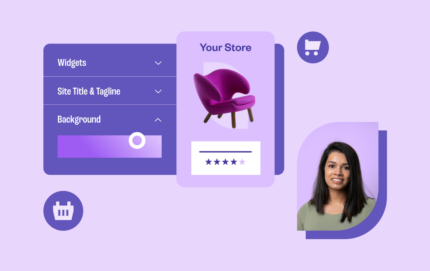Social media has different layers, but as a whole, it’s about people. It acts as a virtual platform for people to express themselves, communicate with their friends and family and connect with brands they adore. On the flip-side, it’s a space where digital entrepreneurs like you can give your brand a voice and personality, make connections with your followers, listen to their feedback and solve their problems.
Irrespective of how big your online business is, it’s important to be approachable on social media, as this not only creates a positive customer experience but also encourages word of mouth, which is priceless. To help you create an authentic social media presence, we’ve outlined some tips below that can help you proactively engage with your social media followers and inspire them to become loyal customers.
1. Focus on the people and not the results
While it’s important to strive towards your conversion goals of attracting website visitors and getting more social media followers, the most important thing to remember is that you’re dealing with people and not numbers. The best way to ensure you don’t get off track is to step into your customers’ shoes to determine what their needs may be and what questions they need to be answered.
When you communicate with your followers, do your best to sound like a real person, using your brand’s tone, by being friendly, transparent and authentic. Even if you get the same query multiple times it’s important to tailor each response to the individual you’re dealing with so it’s not the same impersonal response every time.
2. Be proactive and not reactive
Proactively engaging with your followers is key to your online business succeeding on social media. Instead of just waiting for comments or messages to respond to, why not look for opportunities to add value and strengthen your relationship with your customers? Research to find out more about your audience and join Facebook groups that include your ideal audience as members, and try to offer valuable input without directly selling your brand. You can do the same thing by searching for relevant mentions of your brand, products or services and providing useful input.
3. Respond to comments
When it comes to managing comments on your posts or social media page, whenever possible leave a reply or even just a ‘like’ to demonstrate that you acknowledge what your followers have to say. When replying, it’s important to act interested while being polite and respectful, with the goal of adding as much value as possible. This includes responding to both positive and negative comments and reviews. While it’s important to reply to comments to show your page is active, the main goal here is to build brand awareness, build advocacy and improve visibility amongst your followers.
Wherever possible, avoid doing the following two things:
- Using the same message every time you reply to a comment, rather tweak your wording while keeping your core message.
- Hiding comments, as this can backfire if someone left a complaint and they noticed that you’ve hidden it. Rather respond sympathetically and ask them to send you a private direct message so you can help sort out their problem. At the end of the day, it’ll build trust if your followers see how you manage negative feedback or comments.
It’s also recommended to share and comment on other relevant posts that are suited to your brand’s interests and would therefore be beneficial to your followers. Another option is to scout forums like Reddit or Quora where you can respond to threads as your brand.
4. Monitor conversations related to your business
The best way to determine how your brand is being perceived is to monitor conversations that mention your online store, as well as topics that are relevant to your business or industry. Keeping an eye on things will help your business stay ahead of the pack by having the opportunity to address anything before your competitors do, and overall having more control over what’s being said about your business. A good monitoring strategy can also help you find new conversations to partake in to build your brand awareness, and even present itself as an opportunity to find new products to potentially add to your offering.
Monitoring what your followers and desired audience is engaging with can also help you make informed decisions about the type of content to publish. Play around and test different formats to see what gets the most engagement and response from your community. For tips on how to generate engaging social media content to drive traffic to your online store, check out this blog.
5. Have a communication crisis plan in place
Unfortunately, no matter how hard you work towards maintaining a positive brand image, things can happen that are out of your control that can tarnish your brand. For example, you may run out of stock of a certain product, your website may crash during a sale or a package may get lost in the mail. In such instances, it’s not unheard of for disgruntled customers to take to social media to vent their frustrations publicly. No matter what the cause, it’s important to be prepared so you can effectively deal with the problem and prevent it from getting out of control.
The best way to manage a social media crisis is to first plan ahead by writing pre-drafted responses that are applicable to different potential situations. And then do the following:
- Listen to what the complainees have to say to clearly understand what their issue is while being polite and empathetic.
- Determine how bad the issue is by looking at how many people are complaining about the same issue and their overall sentiment.
- Implement your crisis plan that includes sharing a pre-written response or statement.
- Respond timeously, even if it’s just a statement acknowledging that you’re aware of the situation. It’s best to avoid apologising immediately as this admits liability, rather apologise for how frustrated or angry they are feeling. But if you were indeed in the wrong, apologise.
- Conduct a swift investigation to try and resolve the situation as quickly as possible. Don’t expect your customers to be patient and remain loyal to your brand or service.
- If the problem is big enough and if you think it’s necessary, put your regular business and marketing communications on hold.
- Monitor the situation going forward by keeping track of mentions and the general sentiment.
Running your social media business pages may seem like a fun exercise but in reality, it requires a lot of commitment, hard work and man-hours to get right. As soon as your finances allow it, hire a social media community manager to help you with all of the tips outlined above, even if it’s just on a part-time basis. We hope that this blog post will help you improve your business’s social media engagement strategy to gain loyal followers and customers.
To stay connected follow us on Instagram, Twitter, LinkedIn or Facebook.




